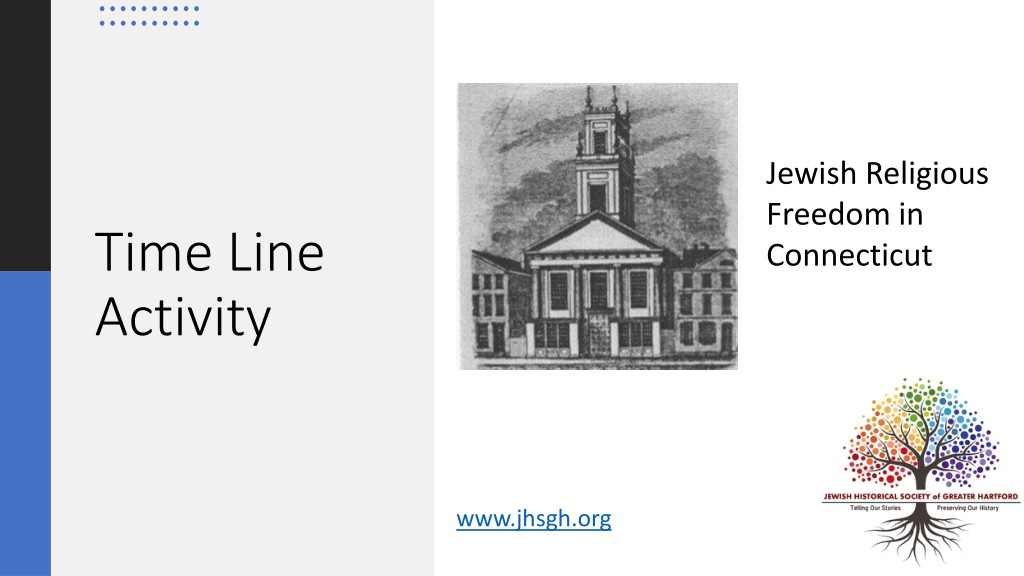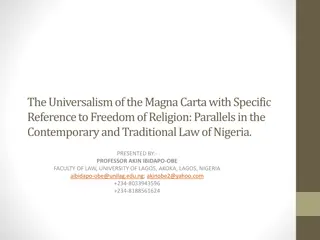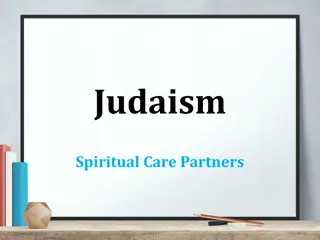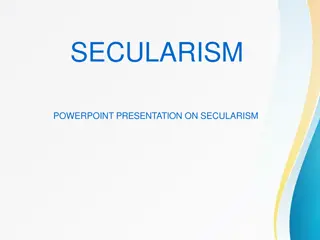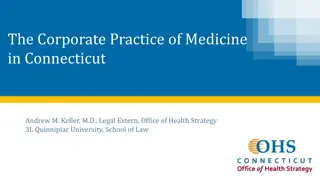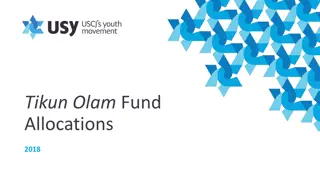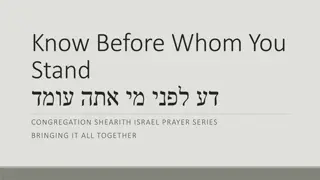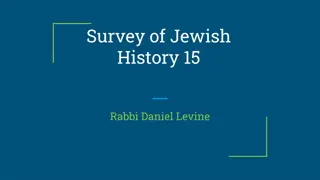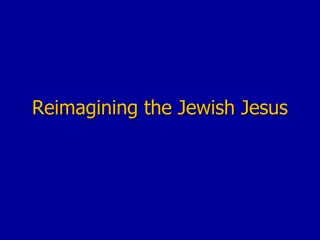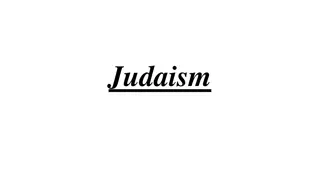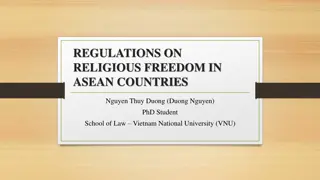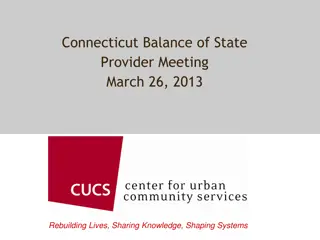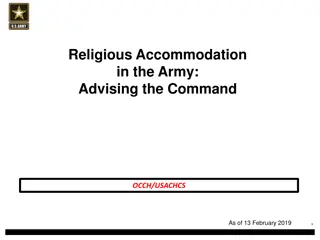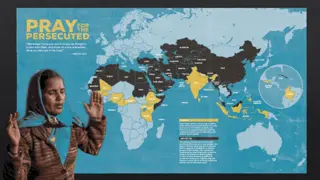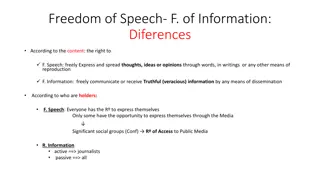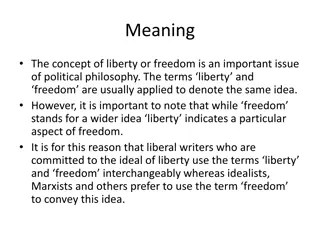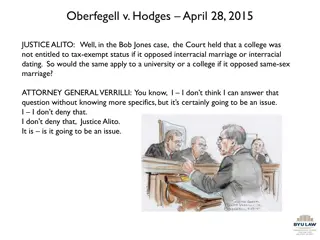Interactive Activity on Jewish Religious Freedom in Connecticut
Explore a time-line activity involving role-playing and interactive learning to understand the history of Jewish religious freedom in Connecticut. Students engage in matching, sequencing, and storytelling to grasp the collective effort behind achieving religious equality. The activity culminates in a reflective exercise on initiating positive change and understanding community advocacy.
Download Presentation

Please find below an Image/Link to download the presentation.
The content on the website is provided AS IS for your information and personal use only. It may not be sold, licensed, or shared on other websites without obtaining consent from the author. Download presentation by click this link. If you encounter any issues during the download, it is possible that the publisher has removed the file from their server.
E N D
Presentation Transcript
Jewish Religious Freedom in Connecticut Time Line Activity www.jhsgh.org
Time Line is a short interactive activity designed to designed to show upper elementary or middle school students that it takes many people from different parts of a community to create change, while actively learning about how Jews had to work with allies to get religious equality here in Connecticut. Overview It would fit into a unit on American Jewish history, civil rights, and/or social action.
There are 6 Role Cards. Each Role Card features a person who played a part in changing the state statute so Jews could have religious freedom in the state of Connecticut. Overview Depending on the size of the class, students can receive cards as individuals or as a group.
Students will first intermingle and inquire with one another to match up WANTS and RESULTS in order to create a chronological timeline. (There are symbols in the corners of the cards that match up in case students have trouble making their match.) Overview Students will then arrange themselves in a line, in chronological order to create a timeline of events and who made them happen. (There are symbols in the corners of the cards that match up in case additional help is needed.)
Students will read from their card in order to create a narrative of what happened and what each person s motivations were. The teacher can add additional information as provided to fill in details or ask questions. Overview By participating in this activity naming specific people and points in history, students should be able to visualize how an inequality in the law was addressed by many individuals and groups working together to change an unjust law.
Follow-up: As a class, think of one thing that they would want to change (at home, at school, in the synagogue, in their town, in their state, etc.). Overview Whom would they contact who has the power to make this change? What would be the request? How could they support their reasoning with facts? Who else would you need to support the idea?
Why is it important for Jews to be able to form synagogues or congregations in the places they live? Introductory Question What would it be like if we didn t have the right to do this?
There are 6 Role Cards. Each Role Card features a person who played a part in changing the state statute so Jews could have religious freedom in the state of Connecticut. Role Cards
I came to New England in the 1600s in pursuit of religious freedom for my kind of Christianity. WANT: Freedom to establish a society based on religious principles Colonial Founder: Thomas Hooker RESULT: Founded the colony of Connecticut. The Puritan or Congregational Church became the official, or established, form of worship. Text: ...the Christian Faith, which in Our Royal Intentions, and the adventurers free Possession, is the only and Connecticut s Royal Charter, 1662 Connecticut s Royal Charter, 1662 principal End of this Plantation. (Connecticut s Royal Charter, 1662, signed by King Charles II of England)
WANT: Religious freedom for all Christian faiths (Anglican, Baptist, Quaker), now that freedom from England meant Connecticut could do as it wished with religious minorities. State Political Leader: Roger Sherman RESULT: In 1784, just after the American Revolution, Connecticut passed an Act for Securing the Rights of Conscience, that secured religious freedom for those professing the Christian religion, of whatever denomination, and decreed they no longer be taxed to support the Congregational church. (Non-Christians could still be taxed to support the church.) Note: U.S. Constitution, First Amendment, 1789: Congress shall make no law respecting an establishment of religion, or prohibiting the free exercise thereof; or abridging the freedom of speech, or of the press; or the right of the people peaceably to assemble, and to petition the Government for a redress of grievances.
WANT: To adjust the State Constitution and separate Church and State Connecticut Convention Delegate: Oliver Ellsworth or John Treadwell RESULT: In 1818, a state convention adopted a new constitution for Connecticut, which separated the state government completely from the Congregational church and allowed Jews the right to vote and hold public office. Some delegates (like Oliver Ellsworth) wanted to provide equal religious rights to everyone, but outgoing Governor John Treadwell successfully made a last-minute motion that added the word Christian back in. Thus, the freedom to form congregations and worship publicly was still limited to Christians.
WANT: The right to organize synagogues and to worship together freely and publicly. Jewish Immigrant Leader: Louis Rothschild* or Theresa Bamberger** RESULT: In 1843, the Jewish leadership drafted a petition to the Connecticut General Assembly, requesting a change in the Connecticut Constitution for religious freedom. * A Bavarian immigrant who owned a business in New Haven and made the petition on behalf of the Jews of New Haven (and presumably Hartford too) ** One of the Jewish community members who wanted a synagogue in Hartford, she would later be a member of Congregation Beth Israel s women s organization
WANT: To have Jewish people treated equally under the law, and (perhaps) encourage more people to settle in Connecticut. Ally: Ira Merwin RESULT: On June 6, 1843, Merwin submitted a petition to the Connecticut General Assembly on behalf of the Jews of New Haven and Hartford requesting a change in the Connecticut Constitution to provide religious rights for Jews.
WANT: To make laws to govern the state of Connecticut. Connecticut Legislator: Noyes Billings RESULT: Representatives denied the request to change the State Constitution in 1843. However, they did pass a special law that allowed Jews the same religious rights as Christians.
Outcome Although the 1843 statute extended religious freedom to Jews, it did not extend this freedom to other non- Christians [Indigenous religions, West African religions, Muslims, Hindus.] In Hartford, after the law was passed, a group of Jews who had been meeting in each other s homes soon formed Congregation Beth Israel. For about 20 years, they worshiped in a former Baptist church building downtown known as Touro Hall. In 1876 they built the Charter Oak Temple the first synagogue in the state designed for that purpose. Congregation Mishkan Israel was founded in New Haven as soon as the new law passed. The congregation purchased a plot of land in Westville, CT for a cemetery that is still in use today. This legal freedom would not happen until 1965 when the wording of the State Constitution was changed. Mishkan Israel later built its own building, Orange Street Temple, in 1897, where it stayed until 1960.
What is a social problem that you, as a class, would like to see addressed to make your community more equal? How would you make a petition, how would you convince others to sign the petition? Follow-up To whom would you send the petition? Would you need an ally?
